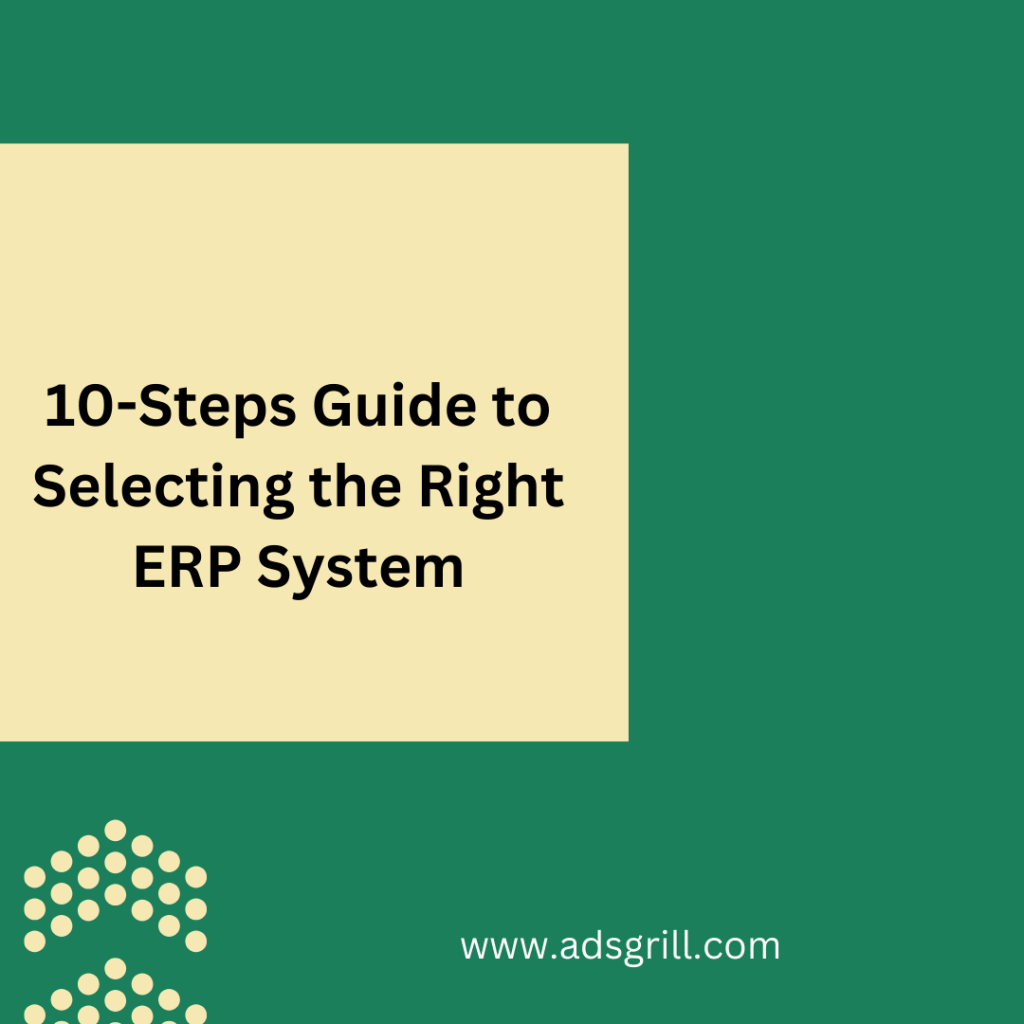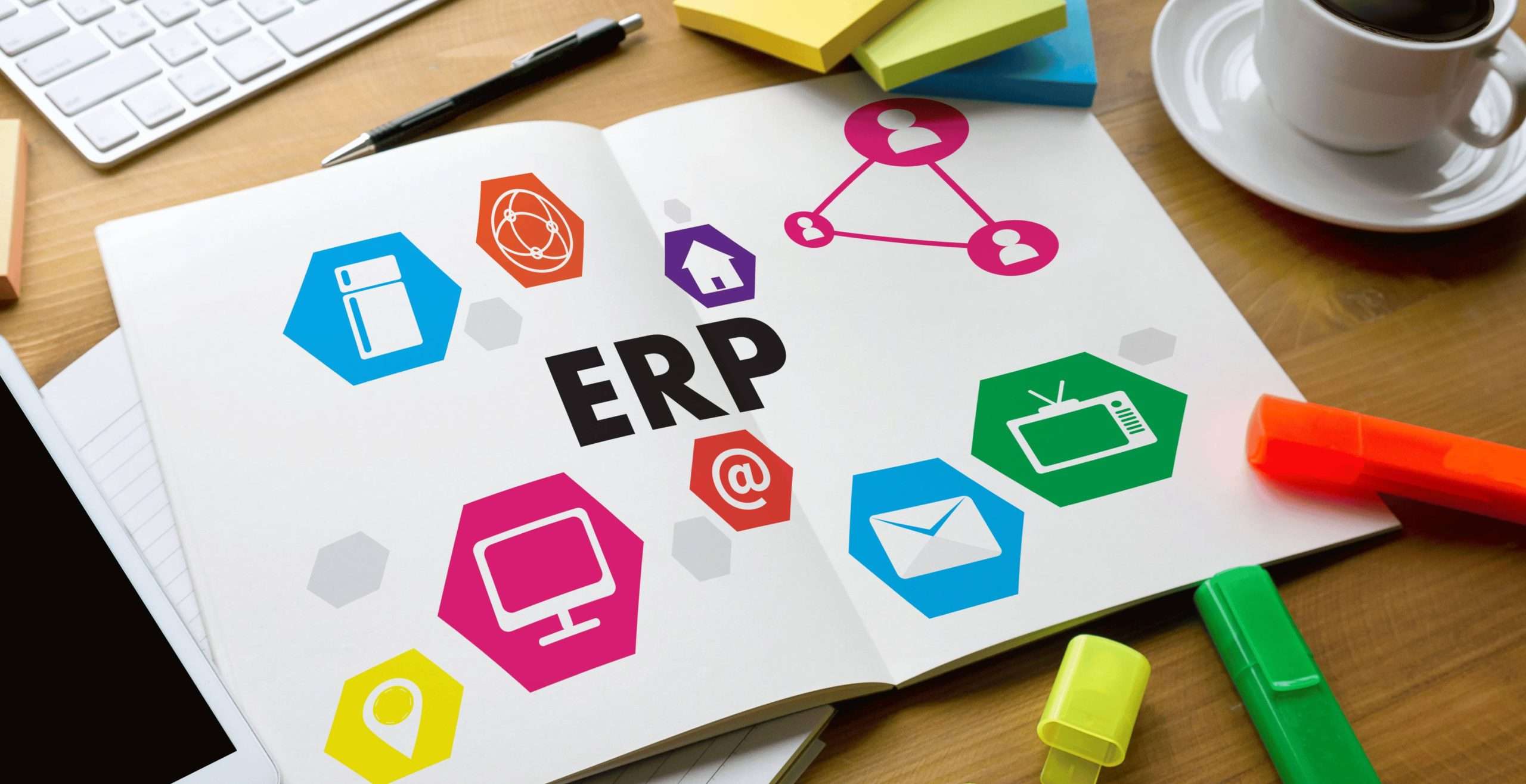
- Introduction
- 1. Business Needs:
- 2. Executive and team support
- 3. Vendor Reputation and Support
- 4. System Functionality and Customisation
- 5. Scalability and Flexibility
- 6. Integration Capabilities
- 7. User-Friendliness and Training Requirements
- 8. Review Pricing and Total Cost of Ownership
- 9. Conduct References and Case Studies
- 10. Make an Informed Decision
- Key Point
Introduction
In today’s digital world, businesses of all sizes have implemented Enterprise Resource Planning (ERP) solutions to simplify operations and connect various company processes, increasing production and improving efficiency, and achieving overall organisational success. However, choosing the right ERP system for your organisation can be challenging. Any organization that wants to implement an ERP system must make a significant investment. With so many options on the market, it is essential to use an organised process to make sure your decision is well-informed. It is important to select a solution that fits your unique requirements and the long-term objectives of your business.
This guide will take you through 10 important steps that will provide you with valuable insights and practical advice to make an informed decision when selecting the Right ERP system. While choosing the right ERP system, take into account the following factors:
1. Define your Business Needs
In the world of entrepreneurship, business operations play a vital role in determining the success and longevity of a company. Operating a business involves a multitude of activities and processes that are necessary to deliver products or services to customers efficiently.
Business Needs Assessment is an important factor that needs to be considered when choosing the right ERP system for an organization. To determine what features and functionalities the ERP system should have, it is necessary to evaluate the present and future business requirements, procedures, and workflows.
While conducting a business needs assessment, organisations should take into account aspects like business goals and objectives, fundamental business activities that the ERP system should support, data management, user requirements, integration requirements, and budget.
Through a thorough assessment of business needs, organizations can ensure that the chosen ERP system is customized to their specific requirements and can help them achieve their business goals. Additionally, this will assist businesses in avoiding choosing an ERP system that does not suit their demands, which can result in a loss of time, money, and resources.
2. Ensure you have Executive and Team support
To ensure a successful implementation, the Executive and Team support must be fully on board with the execution for it to be successful.
The Importance of Executive Support:
A) Strategic Goal Alignment: The implementation of an ERP System requires a strategic strategy. With strong executive support, it becomes easier to align the system’s objectives with the company’s broader strategic goals. Executive need to champion the project and communicate the importance of ERP adoption to the entire organization.
B) Allocating Resources: Implementing an ERP system requires substantial resources, such as time, finances, and manpower. Executive support ensures the availability of these resources throughout the project’s lifecycle. Executives can allocate dedicated teams and assign key personnel responsible for ERP implementation.
c) Overcoming Resistance to Change: Executive support is important in driving acceptance and change management efforts. Executives can foster employee buy-in by clearly articulating the benefits of ERP adoption and involving them in the decision-making process. They can address concerns, and provide training and resources to enhance the team’s readiness for the new system.
The Role of Team Support:
A) Subject Matter Expertise: The team’s involvement ensures that the ERP system selected aligns with the organization’s specific requirements and existing workflows. Identify key team members with expertise in various processes and departments to actively contribute to the selection process. Their insights and knowledge can guide the evaluation and customization of the ERP system.
B) User Adoption and Engagement: Teams need to proactively participate in the selection process to ensure they embrace the new system. Involving the team early on creates a sense of ownership and allows them to voice their needs and concerns concerning the ERP system. Their active participation ensures their buy-in, increasing the chances of a smooth transition and successful implementation.
C)Knowledge Transfer and Training: Team support plays a crucial role in knowledge transfer and training to ensure the organization maximizes the benefits of the ERP system. Encourage sharing of knowledge among team members to build a strong user community and foster continuous learning.
In conclusion, executive and team support are the backbone of a successful ERP implementation. By securing both executive and team support, companies can navigate the intricate process of selecting the right ERP system and position themselves for future growth and success.
3. Assess Vendor Reputation and Support
When choosing the right Enterprise Resource Planning (ERP) system, The importance of taking vendor reputation and support into account is important. Here is a quick breakdown of these factors:
Vendor Reputation: The reputation of the ERP system vendor reflects their track record, credibility, and customer satisfaction. Selecting a provider with a good reputation in the industry is crucial. A reputable vendor is more likely to provide a high-quality ERP system that meets your business needs and delivers reliable performance. They are also more likely to have a strong customer base, which indicates their product’s effectiveness and suitability for various organizations.
Support: ERP implementation and ongoing maintenance require reliable support from the vendor. Adequate assistance makes sure that any problems, errors, or technical problems that arise during the setup or use of the ERP system can be corrected quickly. Strong vendor support includes timely responses to queries, access to knowledgeable support staff, regular updates and patches, and assistance with customization or integration requirements. It’s important to assess the vendor’s support services, including their response times, availability, and degree of knowledge, to make sure you get the help you need when you need it.
Considering both vendor reputation and support helps minimize risks and ensures a smooth ERP implementation and long-term usage. A reputable vendor with reliable support increases the likelihood of a successful ERP implementation, reduces downtime, and provides a solid foundation for your business processes.

4. Evaluate System Functionality and Customisation
Functionality and customization are important factors to consider when choosing the right ERP system for an organization.
Functionality refers to the features and capabilities of the ERP system. The fundamental business processes of the organisation, such as financial management, inventory management, and supply chain management, should be supported by the ERP system. It is important to choose an ERP system with the necessary features to meet the specific business requirements of the organisation.
Customization refers to the ability to modify the ERP system to meet specific business requirements. The ERP system should be flexible enough to accommodate customization without affecting its core functionality. It is important to choose an ERP system that can be easily modified to match the specific business objectives of the organisation without requiring a lot of coding or development efforts.
Organizations can choose an ERP system that supports their essential business activities and can be quickly customized to meet their specific requirements by taking functionality and customization into account during the selection process. This will reduce the need for manual procedures and workarounds while also assisting organisations in achieving greater productivity and efficiency.
5. Consider Scalability and Flexibility
Scalability and flexibility are important factors to consider when choosing the right ERP system for an organization.
Scalability is the ability of the ERP system to adapt organisational development and expansion. As the organization grows, the ERP system should be able to handle increased transaction volumes, additional users, and more complex business processes. It is important to choose an ERP system that can be scaled up or down according to changing needs of the organization.
Flexibility refers to the ability of an ERP system to adapt to changing business requirements and processes. The ERP system should be able to accommodate changes in business processes, workflows, and data management without requiring significant customization or reimplementation.
It’s important to choose an ERP system that can be quickly customised to meet specific needs and is adaptable enough to change business needs.During the selection process, organisations can avoid the need for future expensive upgrades and replacements by ensuring that the ERP system they choose can develop and adapt to their business needs.
6. Analyze Integration Capabilities
When selecting the best ERP system for an organisation, integration capabilities are an important aspect to take into account.
Integration refers to the ability of the ERP system to communicate and exchange data with other programs and systems utilized by the organisation, such as CRM, HR, or e-commerce systems. It is important to select an ERP system that is simple to link with other systems and applications to make sure that data is accurate and current across all platforms.
The ERP system should have the necessary integration capabilities to enable data exchange with other systems, such as APIs, web services, or middle ware. It is important to select an ERP system that can integrate with other systems without requiring significant customization or development efforts.
By considering integration features during the selection process, organizations can ensure that the ERP system they choose can communicate and exchange data with other systems and applications used in the organization, reducing the need for manual data entry and ensuring data consistency across systems. This helps organizations improve efficiency and productivity while lowering the possibility of data errors and inconsistencies.
The user-friendliness of an ERP system refers to how simple and intuitive its user interface and functionalities are to use. With the end user in mind, a user-friendly system is developed, making it simpler for employees at all levels to browse, understand, and complete tasks in the ERP system. Equipped with a well-designed user interface, clear workflow, and intuitive functions, using an ERP system can improve productivity, fewer user errors, and reduce the learning curve.
Also, Adequate training is essential for employees to understand how to use the ERP system effectively. Training programs should cover various aspects of the system, including navigation, data entry, reporting, and specific modules relevant to different roles. The availability of comprehensive training resources, such as documentation, tutorials, and instructor-led sessions, is crucial for a successful implementation. Additionally, ongoing training and support should be provided to address any system updates or new features introduced over time.
Considering user-friendliness helps to ensure that employees can quickly adapt to the ERP system, resulting in higher user adoption rates and increased efficiency. Additionally, providing thorough training equips employees with the necessary skills and knowledge to maximize the benefits of the ERP system and perform their job responsibilities effectively.

8. Review Pricing and Total Cost of Ownership
An important factor in selecting the right Enterprise Resource Planning (ERP) system is the Pricing and Total Cost of Ownership (TCO). It refers to the total costs associated with the installation, operation, and maintaining an ERP system over its life cycle. It encompasses various elements that need to be considered:
First, implementation costs include software licenses, hardware infrastructure, consulting services, data migration, training, and customization expenses. These costs must align with the budget and expected return on investment.
Second, licensing and maintenance fees need to be evaluated. These fees cover software licenses, ongoing support, updates, and upgrades. Understanding the pricing structure and long-term costs associated with licensing and maintenance is essential.
Third, integration and customization expenses should be assessed. Integrating the ERP system with existing applications and customizing it to align with specific business requirements can contribute to the TCO.
Additionally, training and support costs must be considered. Proper training for employees and ongoing support services from the vendor is crucial for successful implementation and usage.
Lastly, upgrades and scalability should be evaluated. The costs associated with system upgrades and their scalability for future growth and expansion need to be taken into account.
By considering the TCO, organizations can make informed decisions, align the ERP system with their budget and business goals, and understand the financial implications of implementation and long-term usage.
9. Conduct References and Case Studies
When it comes to selecting the right Enterprise Resource Planning (ERP) system for your business, conducting references and case studies is an essential step.
By looking into the experiences of other companies that have implemented ERP systems, you can gain valuable insights and make an informed decision. Request references from the ERP vendors and speak with their existing customers. Engage in conversations to understand their experience with the ERP system and vendor’s support services.
Additionally, review case studies to gain insights into successful implementations within your industry. References and case studies highlight the success stories and benefits experienced by other companies.
In conclusion, review case studies to gain insights into successful implementations within your industry. References and case studies highlight the success stories and benefits experienced by other companies. These success stories can motivate your business and provide you with an idea of the good effects an ERP system can have on your operations, such as enhanced productivity, better decision-making, and increased customer satisfaction.
10. Make an Informed Decision
When selecting the right ERP system for your business, making an informed decision is important. With so many options available in the market, it’s important to carefully evaluate and assess each aspect before committing to a particular solution.
After completing the previous nine steps, carefully analyze all the information you have gathered. Compare the ERP systems based on your requirements, vendor credibility, system features, scalability, integration capabilities, user-friendliness, pricing, and customer references.
Make a well-informed decision that supports your organisation’s goals. Keep in mind that making an informed decision will open the way for long-term improvements in effectiveness, productivity, and success.
Remember to involve key stakeholders and engage in thorough testing, demos, and consultations during the selection process. So, these are the 10-Steps Guide to Selecting the Right ERP System, by taking these factors into account, you can choose the right ERP system that suits the particular requirements of your business and achieve your goals.

